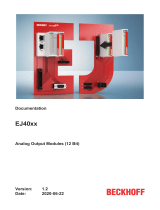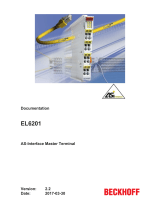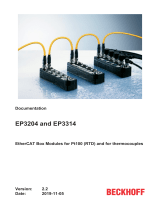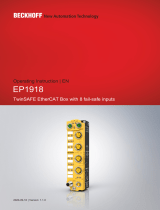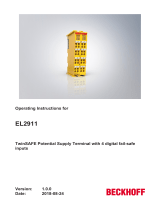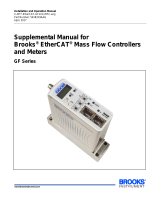Page is loading ...

Documentation
EJ3255
5-Channel Potentiometer Measurement with Sensor Supply
1.1
2020-06-15
Version:
Date:


Table of contents
EJ3255 3Version: 1.1
Table of contents
1 Foreword ....................................................................................................................................................5
1.1 Notes on the documentation..............................................................................................................5
1.2 Safety instructions .............................................................................................................................6
1.3 Intended use......................................................................................................................................7
1.4 Signal distribution board ....................................................................................................................7
1.5 Documentation issue status ..............................................................................................................7
1.6 Guide through documentation ...........................................................................................................7
1.7 Marking of EtherCAT plug-in modules...............................................................................................8
1.7.1 Beckhoff Identification Code (BIC)................................................................................... 11
1.7.2 Certificates....................................................................................................................... 13
2 System overview .....................................................................................................................................14
3 Product overview.....................................................................................................................................15
3.1 EJ3255 - Introduction ......................................................................................................................15
3.2 EJ3255 - Technical data..................................................................................................................16
3.3 EJ3255 - Pinout ...............................................................................................................................17
3.4 EJ3255 - LEDs ................................................................................................................................18
4 Installation of EJ modules ......................................................................................................................19
4.1 Power supply for the EtherCAT plug-in modules.............................................................................19
4.2 EJxxxx - dimensions........................................................................................................................21
4.3 Installation positions and minimum distances .................................................................................22
4.3.1 Minimum distances for ensuring installability................................................................... 22
4.3.2 Installation positions ........................................................................................................ 23
4.4 Codings ...........................................................................................................................................25
4.4.1 Color coding..................................................................................................................... 25
4.4.2 Mechanical position coding.............................................................................................. 26
4.5 Installation on the signal distribution board .....................................................................................27
4.6 Extension options ............................................................................................................................29
4.6.1 Using placeholder modules for unused slots ................................................................... 29
4.6.2 Linking with EtherCAT Terminals and EtherCAT Box modules via an Ethernet/EtherCAT
connection ....................................................................................................................... 30
4.7 IPC integration.................................................................................................................................31
4.8 Disassembly of the signal distribution board ...................................................................................33
5 EtherCAT basics......................................................................................................................................34
6 Commissioning........................................................................................................................................35
6.1 Note on documentation for the EL3255...........................................................................................35
6.2 EJ3255 - Object description and parameterization..........................................................................35
6.2.1 Restore object.................................................................................................................. 36
6.2.2 Configuration data ........................................................................................................... 36
6.2.3 Profile-specific objects (0x6000-0xFFFF) ........................................................................ 37
6.2.4 Input data......................................................................................................................... 37
6.2.5 Configuration data vendor-specific .................................................................................. 38
6.2.6 Information and diagnostic data....................................................................................... 38
6.2.7 Standard objects (0x1000-0x1FFF) ................................................................................. 38

Table of contents
EJ32554 Version: 1.1
7 Appendix ..................................................................................................................................................46
7.1 EtherCAT AL Status Codes.............................................................................................................46
7.2 EJ3255 - Firmware compatibility .....................................................................................................46
7.3 Firmware Update EL/ES/EM/ELM/EPxxxx ......................................................................................46
7.3.1 Device description ESI file/XML....................................................................................... 47
7.3.2 Firmware explanation ...................................................................................................... 50
7.3.3 Updating controller firmware *.efw................................................................................... 51
7.3.4 FPGA firmware *.rbf......................................................................................................... 53
7.3.5 Simultaneous updating of several EtherCAT devices...................................................... 57
7.4 Restoring the delivery state .............................................................................................................58
7.5 Support and Service ........................................................................................................................59

Foreword
EJ3255 5Version: 1.1
1 Foreword
1.1 Notes on the documentation
Intended audience
This description is only intended for the use of trained specialists in control and automation engineering who
are familiar with the applicable national standards.
It is essential that the documentation and the following notes and explanations are followed when installing
and commissioning these components.
It is the duty of the technical personnel to use the documentation published at the respective time of each
installation and commissioning.
The responsible staff must ensure that the application or use of the products described satisfy all the
requirements for safety, including all the relevant laws, regulations, guidelines and standards.
Disclaimer
The documentation has been prepared with care. The products described are, however, constantly under
development.
We reserve the right to revise and change the documentation at any time and without prior announcement.
No claims for the modification of products that have already been supplied may be made on the basis of the
data, diagrams and descriptions in this documentation.
Trademarks
Beckhoff
®
, TwinCAT
®
, EtherCAT
®
, EtherCATG
®
, EtherCATG10
®
, EtherCATP
®
, SafetyoverEtherCAT
®
,
TwinSAFE
®
, XFC
®
, XTS
®
and XPlanar
®
are registered trademarks of and licensed by Beckhoff Automation
GmbH. Other designations used in this publication may be trademarks whose use by third parties for their
own purposes could violate the rights of the owners.
Patent Pending
The EtherCAT Technology is covered, including but not limited to the following patent applications and
patents: EP1590927, EP1789857, EP1456722, EP2137893, DE102015105702 with corresponding
applications or registrations in various other countries.
EtherCAT
®
is registered trademark and patented technology, licensed by Beckhoff Automation GmbH,
Germany.
Copyright
© Beckhoff Automation GmbH & Co. KG, Germany.
The reproduction, distribution and utilization of this document as well as the communication of its contents to
others without express authorization are prohibited.
Offenders will be held liable for the payment of damages. All rights reserved in the event of the grant of a
patent, utility model or design.

Foreword
EJ32556 Version: 1.1
1.2 Safety instructions
Safety regulations
Please note the following safety instructions and explanations!
Product-specific safety instructions can be found on following pages or in the areas mounting, wiring,
commissioning etc.
Exclusion of liability
All the components are supplied in particular hardware and software configurations appropriate for the
application. Modifications to hardware or software configurations other than those described in the
documentation are not permitted, and nullify the liability of Beckhoff Automation GmbH & Co. KG.
Personnel qualification
This description is only intended for trained specialists in control, automation and drive engineering who are
familiar with the applicable national standards.
Description of instructions
In this documentation the following instructions are used.
These instructions must be read carefully and followed without fail!
DANGER
Serious risk of injury!
Failure to follow this safety instruction directly endangers the life and health of persons.
WARNING
Risk of injury!
Failure to follow this safety instruction endangers the life and health of persons.
CAUTION
Personal injuries!
Failure to follow this safety instruction can lead to injuries to persons.
NOTE
Damage to environment/equipment or data loss
Failure to follow this instruction can lead to environmental damage, equipment damage or data loss.
Tip or pointer
This symbol indicates information that contributes to better understanding.

Foreword
EJ3255 7Version: 1.1
1.3 Intended use
WARNING
Caution - Risk of injury!
EJ components may only be used for the purposes described below!
1.4 Signal distribution board
NOTE
Signal distribution board
Make sure that the EtherCAT plug-in modules are used only on a signal distribution board that has been
developed and manufactured in accordance with the Design Guide.
1.5 Documentation issue status
Version Comment
1.1 • Chapters Basics communication, TwinCAT Quick Start , TwinCAT development
environment and General Notes - EtherCAT Slave Application replaced by
references in the chapter Guide through documentation
• Chapter EJ3255 - Object description and parameterization added
• Update chapter EJ3255 - Pinout
1.0 • First publication EJ3255
1.6 Guide through documentation
NOTE
Further components of documentation
The documentations named in the following table are further compontents of the complete
documentation. These documentations are required for the use of EtherCAT plug-in mod-
ules.

Foreword
EJ32558 Version: 1.1
No. Title Description
[1]
EtherCAT System Documentation
• System overview
• EtherCAT basics
• Cable redundancy
• Hot Connect
• Distributed Clocks
• Configuration of EtherCAT-Components
[2]
Infrastructure for EtherCAT/Ethernet
• Technical recommendations and notes for
design, implementation an testing
[3]
Design GuideSignal-Distribution-Board for
standard EtherCAT plug-in modules
Requirements for the design of a Signal-
Distribution-Board for standard EtherCAT plug-in
modules
• Backplane mounting guidelines
• Module placement
• Routing guidelines
[4] Documentation of the corresponding terminal
ELxxxx
• Notes on the principle of operation and
• Descriptions for configuration and
parameterization
are transferable to the corresponding Module
EJxxxx (s. note on documentation of ELxxxx
[}35]).
1.7 Marking of EtherCAT plug-in modules
Designation
A Beckhoff EtherCAT device has a 14-digit technical designation, made up as follows (e.g.
EJ1008-0000-0017)
• Order identifier
◦ family key: EJ
◦ product designation: The first digit of product designation is used for assignment to a product
group (e.g. EJ2xxx = digital output module).
◦ Version number: The four digit version number identifies different product variants.
• Revision number:
It is incremented when changes are made to the product.
The Order identifier and the revision number are printed on the side of EtherCAT plug-in modules (s.
following illustration (A and B).

Foreword
EJ3255 9Version: 1.1
Fig.1: Order identifier (A), Revision number (B) and serial number (C) using the example of EJ1008
Product group Example
Product designation Version Revision
EtherCAT Coupler
EJ11xx
EJ1101 -0022
(Coupler with external connectors, power supply module and
optional ID switches
-0016
Digital input modules
EJ1xxx
EJ1008
8-channel
-0000
(basic type)
-0017
Digital output modules
EJ2xxx
EJ2521
1-channel
-0224
(2 x 24V outputs)
-0016
Analog input modules
EJ3xxx
EJ3318
8-channel thermocouple
-0000
(basic type)
-0017
Analog output modules
EJ4xxx
EJ4134
4-channel
-0000
(basic type)
-0019
Special function modules
EJ5xxx, EJ6xxx
EJ6224
IO-Link master
-0090
(with TwinSAFE SC)
-0016
Motion modules
EJ7xxx
EJ7211
servomotor
-9414
(with ECT, STO and TwinSAFE SC)
-0029
Notes
• The elements mentioned above result in the technical designation. EJ1008-0000-0017 is used in the
example below.
• EJ1008-0000 is the order identifier, in the case of “-0000” usually abbreviated to EJ1008.
• The revision -0017 shows the technical progress, such as the extension of features with regard to the
EtherCAT communication, and is managed by Beckhoff.
In principle, a device with a higher revision can replace a device with a lower revision, unless specified
otherwise, e.g. in the documentation.
Associated and synonymous with each revision there is usually a description (ESI, EtherCAT Slave
Information) in the form of an XML file, which is available for download from the Beckhoff web site.
• The product designation, version and revision are read as decimal numbers, even if they are
technically saved in hexadecimal.
Serial number
The serial number for EtherCAT plug-in modules is usually the 8-digit number printed on the side of the
module (see following illustration C). The serial number indicates the configuration in delivery state and
therefore refers to a whole production batch, without distinguishing the individual modules of a batch.

Foreword
EJ325510 Version: 1.1
Fig.2: Order identifier (A), revision number (B) and serial number (C) using the example of EJ1008
Serial number Example serial number: 08 15 08 16
KK - week of production (CW, calendar week) 08 - week of production: 08
YY - year of production 15 - year of production: 2015
FF - firmware version 08 -f irmware version: 08
HH - hardware version 16 - hardware version: 16

Foreword
EJ3255 11Version: 1.1
1.7.1 Beckhoff Identification Code (BIC)
The Beckhoff Identification Code (BIC) is increasingly being applied to Beckhoff products to uniquely identify
the product. The BIC is represented as a Data Matrix Code (DMC, code scheme ECC200), the content is
based on the ANSI standard MH10.8.2-2016.
Fig.3: BIC as data matrix code (DMC, code scheme ECC200)
The BIC will be introduced step by step across all product groups.
Depending on the product, it can be found in the following places:
• on the packaging unit
• directly on the product (if space suffices)
• on the packaging unit and the product
The BIC is machine-readable and contains information that can also be used by the customer for handling
and product management.
Each piece of information can be uniquely identified using the so-called data identifier (ANSI
MH10.8.2-2016). The data identifier is followed by a character string. Both together have a maximum length
according to the table below. If the information is shorter, it shall be replaced by spaces. The data under
positions 1-4 are always available.
The following information is contained:

Foreword
EJ325512 Version: 1.1
Item
no.
Type of informa-
tion
Explanation Data iden-
tifier
Number of digits
incl. data identifier
Example
1 Beckhoff order
number
Beckhoff order number 1P 8 1P072222
2 Beckhoff Traceability
Number (BTN)
Unique serial number,
see note below
S 12 SBTNk4p562d7
3 Article description Beckhoff article
description, e.g. EL1008
1K 32 1KEL1809
4 Quantity Quantity in packaging
unit, e.g. 1, 10, etc.
Q 6 Q1
5 Batch number Optional: Year and week
of production
2P 14 2P4015031800
16
6 ID/serial number Optional: Present-day
serial number system,
e.g. with safety products
51S 12 51S678294104
7 Variant number Optional: Product variant
number on the basis of
standard products
30P 32 30PF971 ,
2*K183
...
Further types of information and data identifiers are used by Beckhoff and serve internal processes.
Structure of the BIC
Example of composite information from items 1 - 4 and 6. The data identifiers are marked in red for better
display:
BTN
An important component of the BIC is the Beckhoff Traceability Number (BTN, item no. 2). The BTN is a
unique serial number consisting of eight characters that will replace all other serial number systems at
Beckhoff in the long term (e.g. batch designations on IO components, previous serial number range for
safety products, etc.). The BTN will also be introduced step by step, so it may happen that the BTN is not yet
coded in the BIC
Notice
This information has been carefully prepared. However, the procedure described is constantly being further
developed. We reserve the right to revise and change procedures and documentation at any time and
without prior notice. No claims for changes can be made from the information, illustrations and descriptions
in this information.

Foreword
EJ3255 13Version: 1.1
1.7.2 Certificates
• The EhterCAT plug-in modules meet the requirements of the EMC and Low Voltage Directive. The CE
mark is printed on the side of the modules.
• The cRUus imprint identifies devices that meet product safety requirements according to U.S. and
Canadian regulations.
• The warning symbol is a request to read the corresponding documentation. The documentations for
EtherCAT plug-in modules can be downloaded from the Beckhoff homepage.
Fig.4: Marking for CE and UL using EJ1008 as an example

System overview
EJ325514 Version: 1.1
2 System overview
Electronically, the EJxxxx EtherCAT plug-in modules are based on the EtherCAT I/O system. The EJ system
consists of the signal distribution board and EtherCAT plug-in modules. It is also possible to connect an IPC
to the EJ system.
The EJ system is suitable for mass production applications, applications with small footprint and applications
requiring a low total weight.
The machine complexity can be extended by means of the following:
• reserve slots,
• the use of placeholder modules,
• linking of EtherCAT Terminals and EtherCAT Boxes via an EtherCAT connection.
The following diagram illustrates an EJ system. The components shown are schematic, to illustrate the
functionality.
Fig.5: EJ system sample
Signal distribution board
The signal distribution board distributes the signals and the power supply to individual application-specific
plug connectors, in order to connect the controller to further machine modules. Using pre-assembled cable
harnesses avoids the need for time-consuming connection of individual wires. Coded components reduce
the unit costs and the risk of miswiring.
Beckhoff offers development of signal distribution boards as an engineering service. Customers have the
option to develop their own signal distribution board, based on the design guide.
EtherCAT plug-in modules
Similar to the EtherCAT terminal system, a module strand consists of a Bus Coupler and I/O modules.
Almost all of the EtherCAT Terminals can also be manufactured in the EJ design as EtherCAT plug-in
modules. The EJ modules are directly attached to the signal distribution board. The communication, signal
distribution and supply take place via the contact pins at the rear of the modules and the PCB tracks of the
signal distribution board. The coding pins at the rear serve as mechanical protection against incorrect
connection. Color coding on the housing facilitates distinguishing of the modules.

Product overview
EJ3255 15Version: 1.1
3 Product overview
3.1 EJ3255 - Introduction
Fig.6: EJ3255
5-channel analog input module, potentiometer measurement with Sensor supply
The EJ3255 EtherCAT plug-in module enables potentiometers to be connected directly. A stabilized power
supply in the module for the connected potentiometers and ratiometric measurement of the input voltage
offer the prerequisites for precise measuring. On account of its high sampling rate and together with
potentiometer position encoders, the compact, 5-channel EtherCAT plug-in module enables a temporally
high-resolution and cost-efficient position detection.
The EJ3255 diagnostics detect broken wire, loss of supply voltage and short-circuit for each channel.
The 5 channels are measured simultaneously (at the same time).

Product overview
EJ325516 Version: 1.1
3.2 EJ3255 - Technical data
Technical data EJ3255
Number of analog inputs 5
Power supply via Up contacts
Technology ratiometric potentiometer evaluation with own supply, 3-wire
connection
Distributed Clocks yes
Feed voltage potentiometer typ. 10V±10%
Internal resistance >> 100kΩ to wiper connection
Input filter limit frequency typ. -3dB at 3kHz and potentiometer 50kΩ
Sensor types Potentiometer 300Ω ..50kΩ
Output current Max. 0.3A total supply current for the potentiometers
Wiring fail indication yes
Conversion time typ. 300 ..700µs, dependent on settings,
default setting: approx.. 500µs (5 channels, filter deactivated)
Resolution 16bits representation (including sign)
Measuring error (total measuring
range)
< ± 0.5% (relative to full scale value)
Electrical isolation 500V (E-bus/signal voltage)
Current consumption load voltage (Up
contacts)
dependent on the potentiometers, max. 70mA
Current consumption via E-bus typ. 80mA
Special Features Open-circuit recognition, supply monitoring, activatable filters
simultaneous measurement of the channels
Permissible ambient temperature range
during operation
0°C .. +55°C
Permissible ambient temperature range
during storage
-25°C .. +85°C
Permissible relative air humidity 95%, no condensation
Operating altitude max. 2,000m
Dimensions (WxHxD) approx. 12mm x 66mm x 55mm
Weight app.30g
Mounting on signal distribution board
Pollution degree 2
Installation position
Standard [}23]
Position of the coding pins [}26]
1 and 6
Color coding green
Vibration/shock resistance according to EN60068-2-6/EN60068-2-27 (with corresponding
signal distribution board)
EMC immunity/emission according to EN61000-6-2/EN61000-6-4 (with corresponding
signal distribution board)
Protection class EJ module: IP20
EJ system: Dependent on the signal distribution board
Approval CE
CE approval
The CE Marking refers to the EtherCAT plug-in module mentioned above.
If the EtherCAT plug-in module is used in the production of a ready-to-use end product (PCB in con-
junction with a housing), the manufacturer of the end product must check compliance of the overall
system with relevant directives and CE certification.
To operate the EtherCAT plug-in modules, they must be installed in a housing.

Product overview
EJ3255 17Version: 1.1
3.3 EJ3255 - Pinout
Fig.7: EJ3255 - Pinout
The PCB footprint can be downloaded from the Beckhoff homepage.
NOTE
Damage to devices possible!
• The pins named with “NC” must not be connected.
• Before installation and commissioning read the chapters Installation of EJ modules
[}19] and Commissioning [}35]!

Product overview
EJ325518 Version: 1.1
3.4 EJ3255 - LEDs
Fig.8: EJ3255 - LEDs
LED Color Display State Description
RUN green off Init State of the EtherCAT State Machine: INIT = initialization of the plug-in module
flashing Pre-Operational State of the EtherCAT State Machine: PREOP = function for mailbox commu-
nication and different default settings set
single flash Safe-Operational State of the EtherCAT State Machine: SAFEOP = verification of the Sync Man-
ager channels and the distributed clocks.
Outputs remain in safe state
on Operational State of the EtherCAT State Machine: OP = normal operating state; mailbox
and process data communication is possible
flickering Bootstrap
State of the EtherCAT State Machine: BOOTSTRAP = function for firmware
updates [}46] of the plug-in module
Up green off - No 24V
DC
power supply connected
on - 24V
DC
power supply connected
ERR1
ERR2
ERR3
ERR4
ERR5
red off - No error
on - There is an error on the corresponding channel:
• Broken wire on wiper or supply
• Potentiometer outside the specified range (300..50kΩ)
• Short-circuit
• Overload
If channels are not used they can be deactivated via the PDO selection. The
corresponding LED goes out.

Installation of EJ modules
EJ3255 19Version: 1.1
4 Installation of EJ modules
4.1 Power supply for the EtherCAT plug-in modules
WARNING
Power supply
A SELV/PELV power supply must be used to supply power for the EJ coupler and modules. Couplers and
modules have to be connected to SELV/PELV circuits exclusively.
The signal distribution board should have a power supply designed for the maximum possible current load of
the module string. Information on the current required from the E-bus supply can be found for each module
in the respective documentation in section “Technical data”, online and in the catalog. The power
requirement of the module string is displayed in the TwinCAT System Manager.
E-bus power supply with EJ1100 or EJ1101-0022 and EJ940x
The EJ1100 Bus Coupler supplies the connected EJ modules with the E-bus system voltage of 3.3V. The
Coupler can accommodate a load up to 2.2A. If a higher current is required, a combination of the coupler
EJ1101-0022 and the power supply units EJ9400 (2.5A) or EJ9404 (12A) should be used. The EJ940x
power supply units can be used as additional supply modules in the module string.
Depending on the application, the following combinations for the E-bus supply are available:
Fig.9: E-bus power supply with EJ1100 or EJ1101-0022 + EJ940x
In the EJ1101-0022 coupler, the RJ45 connectors and optional ID switches are external and can be
positioned anywhere on the signal distribution board, as required. This facilitates feeding through a housing.
The EJ940x power supply plug-in modules provide an optional reset function (see chapter Connection of the
documentation for EJ9400 and EJ9404)

Installation of EJ modules
EJ325520 Version: 1.1
E-bus power supply with CXxxxx and EK1110-004x
The Embedded PC supplies the attached EtherCAT Terminals and the EtherCAT EJ Coupler
• with a supply voltage of 24V
DC
(-15 %/+20%). This voltage supplies the E-bus and the Bus Terminal
electronics.
The CXxxxx units supply the E-bus with up to 2,000mA E-bus current. If a higher current is required
due to the attached terminals, power feed terminals or power supply plug-in modules must be used for
the E-bus supply.
• with a peripheral voltage Up of 24V
DC
to supply the field electronics.
The EK1110-004x EtherCAT EJ Couplers relay the following parameters to the signal distribution board via
the rear connector:
• the E-bus signals,
• the E-bus voltage U
EBUS
(3.3V) and
• the peripheral voltage U
P
(24V
DC
).
Fig.10: PCB with Embedded PC, EK1110-0043 and EJxxxx, rear view EK1110-0043
/
